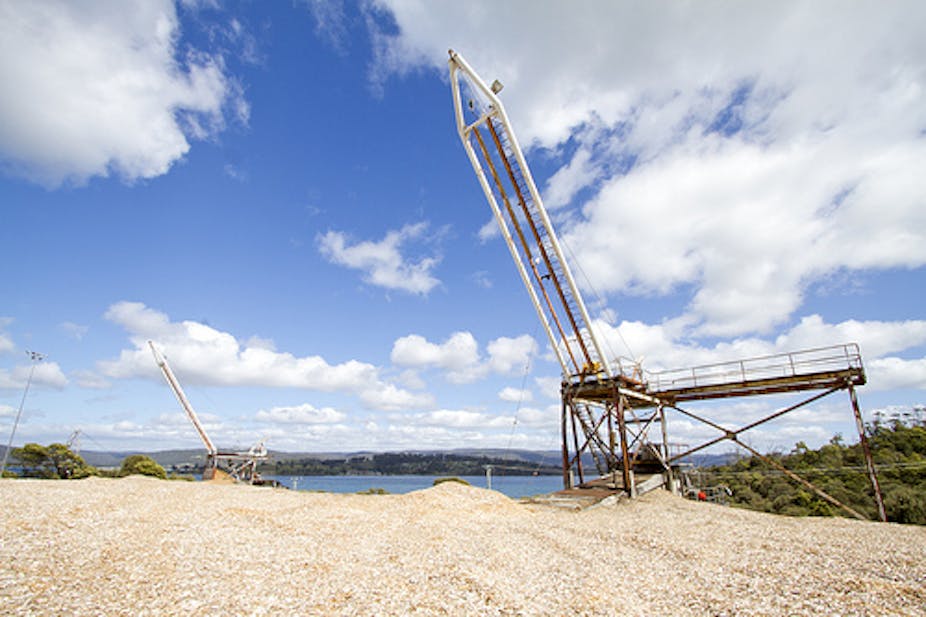Last week, after nearly two years of negotiations, loggers and environmentalists shook hands on a Tasmanian forestry peace deal. The deal represents a landmark in more than 30 years of animosity between the two groups, but it’s unlikely to be a conclusion to the conflict.
The decline of an industry
In the eight years since 2004 - when then Economic Development Minister Lara Giddings declared there were “clear benefits to Tasmania in developing a pulp mill” - a risky gamble has unravelled.
Forest policy was once dominated by the expectation that a very large pulp mill would underwrite plantation forestry, and support large scale clearfelling of public forests by providing an outlet for low-grade timber.
Taxpayers contributed in the form of managed investment schemes and low financial returns to Forestry Tasmania, while investors responded with large scale plantation development - almost all of which has been managed for pulpwood production rather than solid timber.
But since then, the economics of Tasmanian forestry has fundamentally changed. Employment in the industry is less than half what it was in 2008. Forestry Tasmania is forecast to continue to make losses of $25 million per annum, for the next few years.
Apart from the Norske Skog newsprint mill, which is largely based on softwood plantations, profitability of private sector industry is minimal.
Accepting change
In recognition of changed conditions, the Tasmanian and Commonwealth governments in August 2011 signed the Intergovernmental Agreement (IGA), providing a further $277 million to support exit from the industry, protect high conservation value forests and drive structural change.
Implementation of the agreement was supported by a “round table” reference group comprising representatives of the forest industry, unions, and conservation groups. Its primary role was to negotiate a trade-off between additions to reserves and guaranteed wood supply from state forests.
After nearly two years of negotiations, the round table has reached a peace deal which protects a further 500,000 hectares of native forest from logging, while guaranteeing about 137,000 cubic metres of sawlog supply. There are also provisions for access to speciality timbers, and for monitoring harvesting practices.
Uncertain passage
The deal has been ratified by the passage of legislation through the Tasmanian House of Assembly. It will be considered by the Legislative Council, dominated by independent councillors, in two weeks’ time. Its passage there is uncertain.
A legislated agreement would represent a necessary first step in restructuring the Tasmanian forest industry. Its significance rests on the possibility of reducing conflict between conservation groups and loggers.
But the importance of the agreement can be overstated. It has little to say about the root causes of low profitability, or whether taxpayers will be asked for adjustment assistance in addition to the $100 million of IGA money yet to be committed.
Resolving these issues will not be easy, and the locus of dispute is likely to change. Many stakeholders claim that their concerns were not represented in the closed-door negotiations of the round table. The Liberal opposition is supported by sections of industry in opposing the deal in its entirety.
The immediate issues
The Agreement provides for exit assistance for sawmillers and contractors who face cuts in contracted wood supply. If past practice is any guide, this will be given top priority.
More important in the longer run is the management of 200,000 hectares of private plantation timber. Almost all of this resource is on land leased to Gunns, who provided fire protection, pest control and pruning. Ownership of the trees is now uncertain.
The plantations require active management over a longer time to produce solid timber products, and many landowners don’t have the resources or incentives to manage them, or to replant them after harvest. In turn, potential investors in downstream processing face an uncertain supply beyond the next decade.
Similar considerations apply to plantation on public land. To what extent will market forces play out? Or will “picking winners”, as with the pulp mill saga, rule?
Finally, a fundamental restructure of Forestry Tasmania – separating management of production forests from its non-commercial functions – is under consideration.
Whatever the outcome, costs of forest management are likely to rise, and the URS consulting report on which these considerations are based forecasts that production forestry is likely to incur losses for the next five years.
The bottom line: the forests agreement is a beginning, not the end.

